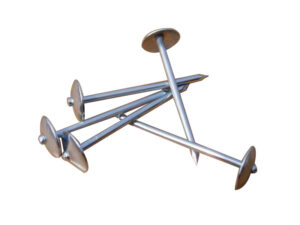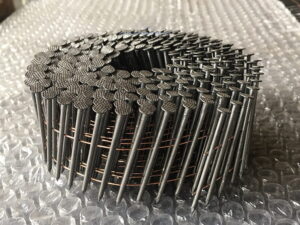In construction and carpentry, where every detail matters, the significance of nails is seldom overlooked. The nail making machine is a crucial contributor to the consistent supply of these small yet indispensable commodities. This article explores what a nail-making machine is and examines its various types, integral components, and legion advantages to manufacturers and end-users.

What is a nail making machine?
A nail making machine is a mechanical device that creates nails of various sizes and shapes. It combines cutting, bending, and welding techniques to form nails from metal rods or wire. The end product can be used for carpentry, construction, and other industrial applications.
These machines come in several types, ranging from simple hand-operated devices to highly advanced computer-controlled models. They are constructed from materials such as steel, aluminum, or plastic and can be manually adjusted or automatically controlled by the machine. The nail-making process involves passing galvanized wire into the machine, which is molded and cut to shape the nails, and the finished nails are automatically collected.
Components of Nail Making Machines
The components of nail-making machines include various spare parts essential for the production line. Some of the standard components are:
- The Nail Mould: As an integral apparatus, the nail mold holds the steel wire in position during the pivotal phase, where the pin punch shapes the nail head. It is designed to grasp the wire with precision and stability, facilitating consistency in the finished nail’s shape and size. Depending on the nail specifications, various molds may be used, highlighting the role of this changeable component in meeting demanding production requirements.
- Nail Cutter: Perhaps the most functional element of the machine, the nail cutter advances the wire and meticulously slices it into the recognizable nail points. Made from high-quality, hardened steel to withstand continuous cutting forces, this cutter helps maintain a swift, steady workflow while ensuring each nail’s length stays uniform.
- Pin Punch: While seemingly small, the pin punch’s role is paramount. This component strikes the prepared wire to form the distinctive nail head. The pin punch necessitates being fabricated from robust materials to endure constant impacts while imparting the correct head shape, thereby contributing to the nail’s ultimate utility.
- Wire Drawing Dies: This facet is pivotal in managing the steel wire’s diameter—slimming it to the required nail size. As the wire is drawn through these dies, it becomes thinner and longer, ready for the subsequent manufacturing steps. This process gives manufacturers control over nail dimensions while preserving wire strength.
- Anvil, Hammer, Die, and Stripper: Collectively forming the body of the nail-making machine, these sections undertake a host of functions—from securing and guiding the wire to executing the cutting and head-forming phases. The anvil provides a solid base for the wire to rest on during the cutting process, the hammer ensures decisive, controlled hits for head formation, the die holds the wire tight, and the stripper adjusts the wire position post-cutting, preparing it for the next nail.
Types of Nail Making Machines
Several nail-making machines are available in the market, each with its characteristics and capabilities. Some of the common types include:
- Traditional Nail Making Machine: This is one of the most common and cheapest nail-making machines. It is known for its low cost, but it can be difficult to guarantee nail quality and is associated with high consumption of raw materials and human effort.
- Super Fast Nail Making Machine: This type is designed to achieve high speeds, with some models capable of producing up to 1100 pcs/min. It is known for its high speed and quality assurance in nail production.
- Automatic Nail Making Machine: These machines are designed to produce common nails, with specific models available for different nail sizes and production lines, such as 1-4 inch or 1-6 inch nail production lines.
- Wire Drawing Machine: While not a nail making machine per se, the wire drawing machine is an essential component in nail production. There are different types of wire drawing machines, such as horizontal type, combined type, and water tank type, each with its advantages in drawing steel wire for nail making.
These machines vary in working principles, production rates, and the types of nails they can produce. Manufacturers often choose the machine that best suits their production needs and quality requirements.
Benefits of Nail Making Machines
Adopting nail-making machines offers many benefits for manufacturers and end users alike. These include:
- Efficiency: Nail-making machines can produce a large number of nails in a short amount of time, saving both time and labor.
- High Quality: These machines produce nails of high quality, which is vital for both professional and DIY users.
- Cost-Effective: They can save money by reducing the labor required to make nails.
- Consistency: Nail-making machines help ensure consistent quality in nail production.
- High Capacity and Low Noise: Automatic steel nail-making machines offer high capacity (up to 1750 pieces per minute) and low noise, making them suitable for various settings.
- Space-Saving and Low Investment: They require small working space and offer low investment, making them suitable for nail-making businesses.
- Safety and Reduced Labor: These machines can save time, space, and labor, increasing safety and efficiency.
- Customization and Versatility: Some machines, such as the Z94 Series, can make a wide range of wire nails and are customizable to fit specific manufacturing requirements.
- Innovative Features: The Enkotec technology machines feature ENKOsmart software touch screens, which enhance production efficiency and quality control.
- Low Production Cost: The design of extrusion nail-making machines simplifies the nail production process, leading to low production costs and benefits for marketing and promotion.
In conclusion
Nail-making machines are crucial in many industries, particularly construction and manufacturing. They demonstrate technological advancements and mechanical intricacies by transforming bare wire, from buildings to furniture, into durable nails that hold our world together. These machines come in various types to cover different production scales and needs, optimizing efficiency, providing the highest quality, and saving costs. These characteristics benefit manufacturers and end-users, promoting economic productivity and advancing their industries.






